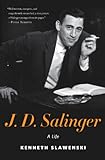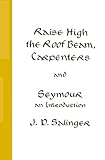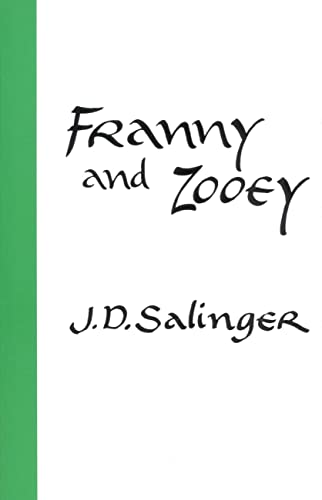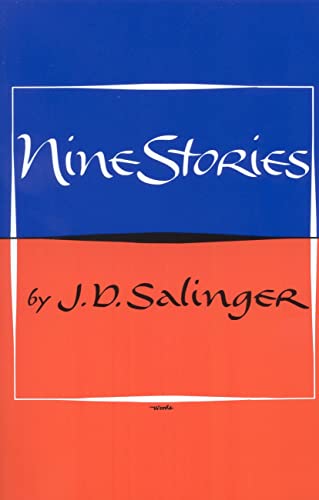 Before I say anything about Kenneth Slawenski’s compelling but adoring biography of J.D. Salinger, I have a question: does anyone really, really understand just why Seymour Glass blows his brains out at the end of “A Perfect Day for Bananafish”? The editors of The New Yorker didn’t, although they eventually published it. John Updike didn’t, but that didn’t keep him from calling the story a classic. Vladimir Nabokov thought it was an “A-plus story” but never said why. The story was published in 1948, three years before The Catcher in the Rye, and it’s been confounding readers ever since.
Before I say anything about Kenneth Slawenski’s compelling but adoring biography of J.D. Salinger, I have a question: does anyone really, really understand just why Seymour Glass blows his brains out at the end of “A Perfect Day for Bananafish”? The editors of The New Yorker didn’t, although they eventually published it. John Updike didn’t, but that didn’t keep him from calling the story a classic. Vladimir Nabokov thought it was an “A-plus story” but never said why. The story was published in 1948, three years before The Catcher in the Rye, and it’s been confounding readers ever since.
You remember what happens. A married couple, Seymour and Muriel, are vacationing in Miami. Muriel, pretty but vapid, sits alone in a hotel room, drying her nails and talking on the phone to her mom, who wants her to come home. The mom thinks Seymour is crazy. She cites instances, says something about the army releasing Seymour from the hospital too soon. Muriel shrugs it off and talks about fashion. Meanwhile, Seymour is on the beach talking to Sybil, a little girl he has come to know. They talk about Muriel, whom Seymour doesn’t seem like. Apropos of nothing, Seymour quotes T.S. Eliot. Seymour and Sybil take a raft and hit the waves. He tells her about bananafish, which crawl into underwater caves, eat so many bananas they can’t get out, and die. Sybil claims to see such a fish and Seymour suddenly decides to go back to shore. He heads for his hotel room. On the elevator up, he accuses another guest of staring at his feet and being a God damned sneak about it. He goes to his room, sees Muriel asleep on the bed, puts a gun to his head and fires. End of story.
WTF? Critical analysis seems to turn on the little girl’s name: Sybil, therefore Sibyl, the mythological seer. Slawenski, a good if somewhat stiff reader of Salinger, offers an even more complicated theory that suggests Seymour spent too much time reading Eliot and Blake. Both ideas may be perfectly correct, but they ignore the fact that Seymour packed the gun to begin with, beside which Eliot and mythology just seem like so much literary filigree. Presumably, Seymour feels trapped, like the bananafish, but the events of this day offer less than perfect motivation. It’s not clear even Salinger knows why Seymour killed himself, because he keeps coming back to it in subsequent stories, as if there’s something he forgot to say, some detail he meant to add.


 The story is the kickoff to Nine Stories, a classic collection distinguished by ambiguity and ellipsis. It was also the beginning of a long journey. In the 25 years of Salinger’s publishing life, Seymour was his constant companion, evolving in seemingly autobiographical ways as the author became more immersed in Eastern philosophy. He’s the brilliant spiritual loner, too preoccupied with the next world to connect with this one, and in death he becomes a ghost his family cannot exorcise. In Franny and Zooey, Seymour’s little sister has a nervous breakdown on the road to spiritual perfection. In Raise High the Roofbeams, Carpenters, a hilarious social comedy, brother Buddy recalls the disastrous events of Seymour’s wedding day. In Seymour: An Introduction, Buddy circles around his memories of Seymour, trying to make some sense of him. It’s Salinger’s most direct effort to say who, what or why Seymour is, and it’s a numbing experience; little more than an endless ramble, and quite the longest novella ever written. Buddy mentions a short story he wrote in the late forties, where Seymour “not only appeared in the flesh but walked, talked, went for a dip in the ocean, and fired a bullet through his brain in the last paragraph.” But the Seymour of the story, he says, was actually more a reflection of Buddy himself, written not long after Seymour’s death, after the both of them had “returned from the European Theater of Operations.” The story, he says, was written using a German typewriter.
The story is the kickoff to Nine Stories, a classic collection distinguished by ambiguity and ellipsis. It was also the beginning of a long journey. In the 25 years of Salinger’s publishing life, Seymour was his constant companion, evolving in seemingly autobiographical ways as the author became more immersed in Eastern philosophy. He’s the brilliant spiritual loner, too preoccupied with the next world to connect with this one, and in death he becomes a ghost his family cannot exorcise. In Franny and Zooey, Seymour’s little sister has a nervous breakdown on the road to spiritual perfection. In Raise High the Roofbeams, Carpenters, a hilarious social comedy, brother Buddy recalls the disastrous events of Seymour’s wedding day. In Seymour: An Introduction, Buddy circles around his memories of Seymour, trying to make some sense of him. It’s Salinger’s most direct effort to say who, what or why Seymour is, and it’s a numbing experience; little more than an endless ramble, and quite the longest novella ever written. Buddy mentions a short story he wrote in the late forties, where Seymour “not only appeared in the flesh but walked, talked, went for a dip in the ocean, and fired a bullet through his brain in the last paragraph.” But the Seymour of the story, he says, was actually more a reflection of Buddy himself, written not long after Seymour’s death, after the both of them had “returned from the European Theater of Operations.” The story, he says, was written using a German typewriter.
In other words, Seymour (or Buddy, who seems to be channeling him, even though he gets little more than static) was tormented by what he saw in the war, as Muriel’s mother suggested, specifically in Germany. That seems like it should be the last word, except that it’s not. We still have Salinger’s bizarre final testament to Seymour: “Hapworth 16, 1924“, which landed with a thud when it appeared in The New Yorker in 1965, taking up a whole issue and marking Salinger’s final publication.
It’s composed of seven-year-old Seymour’s impossibly brilliant 65-page letter home from summer camp, in which we learn that he has already died and been reincarnated several times. It was a strange, unbelievable prequel: the young man who killed himself in a Miami hotel room was actually a homegrown Dalai Lama! As character development goes, it feels desperate. It was also a retread, as the young Seymour isn’t all that different from the title character of Salinger’s story “Teddy,” another child genius touched by some kind of Zen-like divinity.
After that, the clock stopped. Salinger was dead as a writer but, in his Seymour-like way, lives on. His books have never gone out of print, and his earliest and best work remains distinct, irreplaceable, and influential. By the time he got to Hapworth, alas, he had eaten his last banana. He was 46, holed up in a remote house in tiny Cornish, N.H., living off royalties that by the mid-1980s were bringing him about $100,000 a year. He devoted what turned out to be the next half of his life to saying nothing and saying it loud enough for all the world to hear. Rumor had it he still wrote and even completed a few novels, but that remains to be seen, or not seen.
Reading Salinger’s biography is a little like reading the fiction: the more time you spend in his company, the more anxious you are to leave. As far as telling the story, this book has a lot of merit. Slawenski collates all the known facts, tracks his movements over the years, and shows how his art was shaped by both World War II and religion. He does an especially good job of putting Salinger’s experiences in context, particularly where his military years are concerned.
On the other hand, he lacks detachment. He doesn’t hide the warts, but he doesn’t always notice them. To paraphrase Updike paraphrasing Salinger, he loves the author more than God does. He does a very thorough job, however, and it’s not his fault that his subject turns into such a fusty, frosty, petulant bore.
The book starts off quite interestingly, as Slawenski presents a young man who was a little like Holden Caulfield, the narrator of Salinger’s most famous novel: born to an affluent Manhattan family, he attended prep school, and was a bit of an outsider. Far from being a self-loathing manic-depressive, he was arrogant and cocky. The family called him Sonny. He was tall, lanky, affable enough to serve on the entertainment staff of a cruise ship, and he got dates. Among his early conquests was Oona O’Neill, daughter of the playwright, whom he found attractive and classy but also vain and dull. When she dumped him for Charlie Chaplin, he turned her into Muriel Glass.
Readers know Salinger on the basis of the four slim books he allowed into print, which together give the impression he’s never been anything but mature and polished. The 22 stories that make up Salinger’s apprentice work apparently tell a different story; as described here – and Slawenski makes one wish they don’t stay uncollected forever – they were largely commercial fiction that showed promise and occasionally impressed the right people.
When the story “Slight Rebellion Off Madison” was accepted by The New Yorker in 1941, Salinger was poised to enter the big leagues. After the attack on Pearl Harbor, the magazine postponed publication for five years; the story of a rich kid on a date in Manhattan, where he does a lot of drinking, talking and crying, suddenly seemed irrelevant. While the delay was a crushing blow, it probably helped Salinger in the end. He joined the Army and took his character Holden with him. He would see extensive action in the war and participate in key events: he was in Normandy on D-Day, when a full two-thirds of his division was wiped out, spent a bleak winter fighting off Nazi forces in the Hürtgen Forest and, thanks to his command of the language, even worked in counterintelligence as his regiment moved into Germany.
“The notion of J.D. Salinger rushing from house to house, seizing villains, and grilling them under naked lightbulbs might appear absurd to us today but that is exactly what happened,” Slawenski writes.
After thinking he had seen the absolute worst the war had to offer, he helped liberate Dachau. “You could live a lifetime,” he later said, “and never really get the smell of burning flesh out of your nose.” In the end, he would receive five battle stars and the Presidential Unit Citation for valor.
Through it all, writing in barracks and foxholes, he was finding Holden’s voice. What began as a series of stories would eventually be shaped into one long picaresque tale about a troubled kid with a messianic complex, wandering through Manhattan, pondering society at its most phony and the city at its most vomity.
“I know this boy I’m writing about so well,” he told an early editor. “He deserves to be a novel.“ The story took on a tragic dimension; the specter of dying young – like Holden’s brother 10-year-old brother Allie, who remains forever innocent — hangs over the novel. The novel’s famous final lines were Salinger’s own answer to why he would later find the war so hard to talk about: “Don’t ever tell anybody anything. If you do, you start missing everybody.”
The novel that resulted, The Catcher in the Rye, is a masterpiece of narrative first person voice: self-observant but not always self-aware. Holden reveals himself in ways he fully intends – cynical, smart-alecky, funny, romantic – and ways he doesn’t, exactly; he’s immature, annoying, and at times a bit of a phony himself. He speaks in a jazzy, rhythmic argot of goddam, moron, “like a bastard,” “kills me,” “depressed the hell out of me,” and ”sexy,” which can mean either attractive or horny. It’s a voice as genuine as Ishmael, Huck Finn, Humbert Humbert, or anyone else you care to name.
The war affected other Salinger stories as well. Like Sergeant X in “For Esme, With Love and Squalor,” Salinger suffered from what we now know as post-traumatic stress disorder. Also, in a strange life- imitates-art-imitates-life twist, he supposedly fell in love with his first wife, Claire, because she embodied his imaginary war orphan, Esme, and would serve as the inspiration for Franny Glass.
 During this time, Salinger, who was raised in a joint Catholic-Jewish household and had embraced Zen Buddhism, studied the 1,000-plus pages of The Gospels of Sri Ramakrishna, which completely changed his game. It was the book that proclaimed the gospel of Vedanta, a monotheistic religion that absorbs a lot of religious traditions, “accepting all faiths as being valid as long as they lead to the recognition of God.” As Slawenski explains: “The aim of Vedanta is to see God, to become one with God, by looking beyond the shell and perceiving the holiness within” – all of which he started working into his fiction from that point, most successfully in Franny and Zooey.
During this time, Salinger, who was raised in a joint Catholic-Jewish household and had embraced Zen Buddhism, studied the 1,000-plus pages of The Gospels of Sri Ramakrishna, which completely changed his game. It was the book that proclaimed the gospel of Vedanta, a monotheistic religion that absorbs a lot of religious traditions, “accepting all faiths as being valid as long as they lead to the recognition of God.” As Slawenski explains: “The aim of Vedanta is to see God, to become one with God, by looking beyond the shell and perceiving the holiness within” – all of which he started working into his fiction from that point, most successfully in Franny and Zooey.
The two long stories that make up this novel have a fascinating publishing history, as both were published separately in The New Yorker and one almost didn’t make it. Fiction editors William Maxwell and Katherine White couldn’t stand “Zooey” and rejected it. Editor William Shawn not only overruled them, but also worked on the story with Salinger for months. Both stories were a huge success with readers; much less so with critics, who found both characters a couple of preening, self-absorbed, condescending ninnies – views which Norman Mailer suggested “may come from nothing more graceful than envy.”
 I think the novel is the best exposition of Salinger’s own religious quest, and in a curious, roundabout way reminds me of Marilynne Robinson’s Gilead; it erases the line between “religious novel” and “novel about religion.” It’s also very energetic. Slawenski ably digs away at the novels Vedantic ideas, but he misses the fact that it’s so dramatically, irrepressibly alive. He misses Franny, the greatest college girl in American Literature, with her spiritedness, her “irreproachably Americanese” figure, and her thoughts running a mile a minute as she burns through one cigarette after the next.
I think the novel is the best exposition of Salinger’s own religious quest, and in a curious, roundabout way reminds me of Marilynne Robinson’s Gilead; it erases the line between “religious novel” and “novel about religion.” It’s also very energetic. Slawenski ably digs away at the novels Vedantic ideas, but he misses the fact that it’s so dramatically, irrepressibly alive. He misses Franny, the greatest college girl in American Literature, with her spiritedness, her “irreproachably Americanese” figure, and her thoughts running a mile a minute as she burns through one cigarette after the next.
Speaking of which, it’s one of the greatest cigarette-smoking novels ever written. Everyone smokes like a freight train; every cigarette has character, every puff has an idea. Smoking is what releases the torrent of thoughts between the two characters as they thrash out the possibilities of praying without ceasing. Zooey drags on his stogie “as if it were a kind of respirator in an otherwise oxygenless world.” It may also be the first novel where there really is such a thing as chicken soup for the soul.
If Slawenski doesn’t always feel the verve of Salinger’s fiction, he does feel his pain, which is considerable. The man was besieged by enemies from every corner. Over and over in this book, I found myself wondering: how it is that a brave, dedicated Nazi-hunter, a genuine inglorious basterd, could get so completely sidetracked by editors who make suggestions to his precious copy or reject it, or publishers who want to pimp out his books with crass covers, or a crummy Hollywood adaptation of a story, or media invaders or readers showing up on his lawn. For a veteran of Hürtgen and Dachau, it seems like small potatoes, and nothing unusual for anyone bent on being a successful writer. But J.D. was simply not the kind of guy to weather the frustrations and get back to his typewriter. He lived in a small world that demanded unswerving loyalty. If you’re an agent like Dorothy Olding, who protects his privacy with your life, or an editor like William Shawn, you’re on the side of the angels. If you’re Story magazine editor Whit Burnett, who bungled an anthology that Salinger was banking on, or his English publisher Jamie Hamilton, who made the mistake of letting a bad paperback cover slip his notice, you’re alienated forever. Slawenski is so quick to take Salinger’s side in all this that at times he sounds like a posthumous enabler.
As far as the facts go, I found little to question outside of one: the news that “A Perfect Day for Bananafish,” published in 1948, inspired Lolita would likely come as a surprise to Nabokov, who was writing his masterpiece at least as early as 1947 (longer than that if you include the early draft from 1939).
Anyone looking for clues to Salinger’s lost years is going to be disappointed: 40 pages covering 45 bland years of marital battles and legal troubles. Perhaps that’s all there is. Maybe, as Buddy Glass once said, “where there’s smoke there’s strawberry Jello, seldom fire.”







